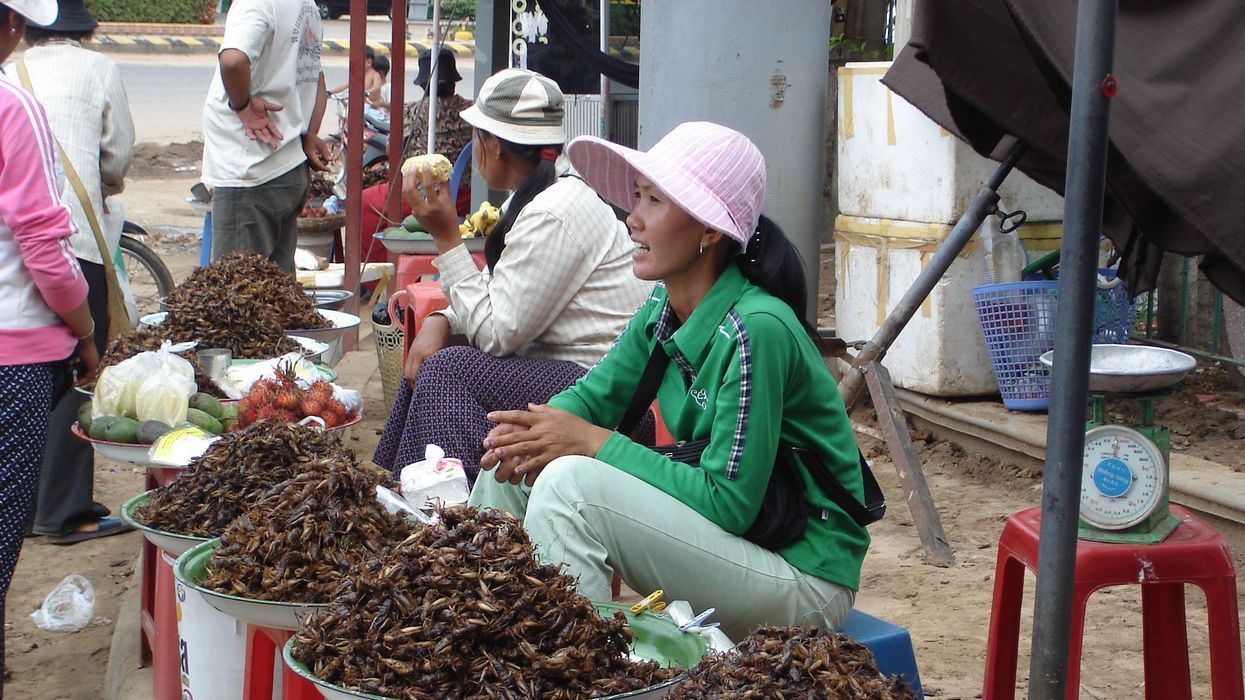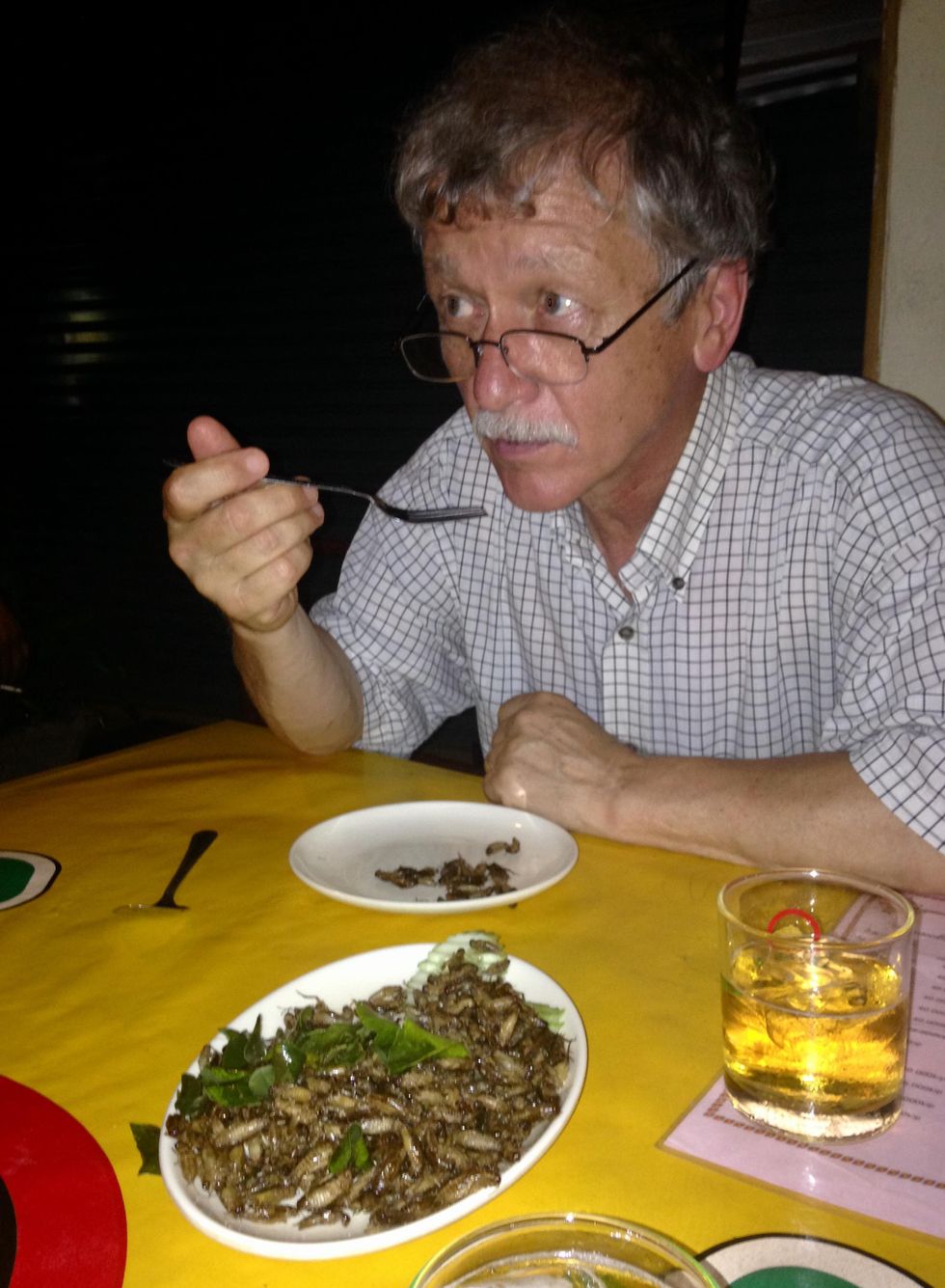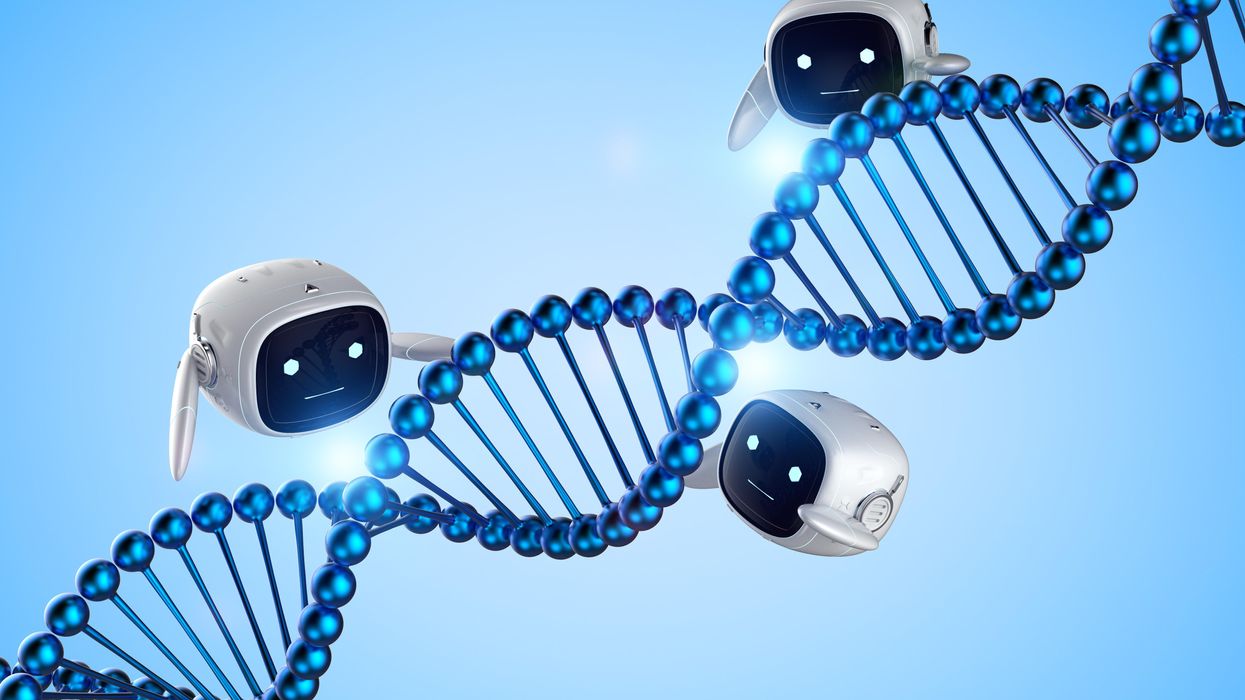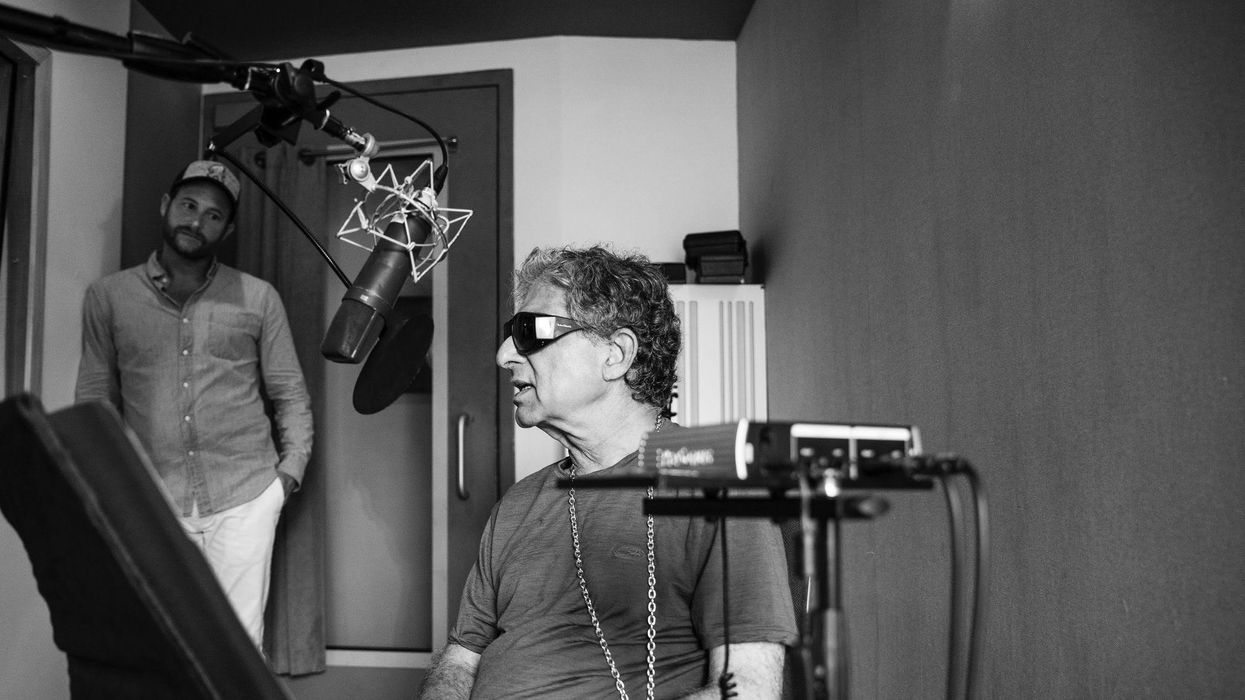Why we should put insects on the menu

Insects for sale at a market in Cambodia.
I walked through the Dong Makkhai forest-products market, just outside of Vientiane, the laid-back capital of the Lao Peoples Democratic Republic or Lao PDR. Piled on rough display tables were varieties of six-legged wildlife–grasshoppers, small white crickets, house crickets, mole crickets, wasps, wasp eggs and larvae, dragonflies, and dung beetles. Some were roasted or fried, but in a few cases, still alive and scrabbling at the bottom of deep plastic bowls. I crunched on some fried crickets and larvae.
One stall offered Giant Asian hornets, both babies and adults. I suppressed my inner squirm and, in the interests of world food security and equity, accepted an offer of the soft, velvety larva; they were smooth on the tongue and of a pleasantly cool, buttery-custard consistency. Because the seller had already given me a free sample, I felt obliged to buy a chunk of the nest with larvae and some dead adults, which the seller mixed with kaffir lime leaves.
The year was 2016 and I was in Lao PDR because Veterinarians without Borders/Vétérinaires sans Frontières-Canada had initiated a project on small-scale cricket farming. The intent was to organize and encourage rural women to grow crickets as a source of supplementary protein and sell them at the market for cash. As a veterinary epidemiologist, I had been trained to exterminate disease spreading insects—Lyme disease-carrying ticks, kissing bugs that carry American Sleeping Sickness and mosquitoes carrying malaria, West Nile and Zika. Now, as part of a global wave promoting insects as a sustainable food source, I was being asked to view arthropods as micro-livestock, and devise management methods to keep them alive and healthy. It was a bit of a mind-bender.
The 21st century wave of entomophagy, or insect eating, first surged in the early 2010s, promoted by a research centre in Wageningen, a university in the Netherlands, conferences organized by the Food and Agriculture Organization of the United Nations, and enthusiastic endorsements by culinary adventurers and celebrities from Europeanized cultures. Headlines announced that two billion people around the world already ate insects, and that if everyone adopted entomophagy we could reduce greenhouse gases, mitigate climate change, and reign in profligate land and water use associated with industrial livestock production.
Furthermore, eating insects was better for human health than eating beef. If we were going to feed the estimated nine billion people with whom we will share the earth in 2050, we would need to make some radical changes in our agriculture and food systems. As one author proclaimed, entomophagy presented us with a last great chance to save the planet.
In 2010, in Kunming, a friend had served me deep-fried bamboo worms. I ate them to be polite. They tasted like French fries, but with heads.
The more recent data suggests that the number of people who eat insects in various forms, though sizeable, may be closer to several hundreds of millions. I knew that from several decades of international veterinary work. Sometimes, for me, insect eating has been simply a way of acknowledging cultural diversity. In 2010, in Kunming, a friend had served me deep-fried bamboo worms. I ate them to be polite. They tasted like French fries, but with heads. My friend said he preferred them chewier. I never thought about them much after that. I certainly had not thought about them as ingredients for human health.
Is consuming insects good for human health? Researchers over the past decade have begun to tease that apart. Some think it might not be useful to use the all-encompassing term insect at all; we don’t lump cows, pigs, chickens into one culinary category. Which insects are we talking about? What are they fed? Were they farmed or foraged? Which stages of the insects are we eating? Do we eat them directly or roasted and ground up?
The overall research indicates that, in general, the usual farmed insects (crickets, locusts, mealworms, soldier fly larvae) have high levels of protein and other important nutrients. If insects are foraged by small groups in Laos, they provide excellent food supplements. Large scale foraging in response to global markets can be incredibly destructive, but soldier fly larvae fed on food waste and used as a substitute for ground up anchovies for farmed fish (as Enterra Feed in Canada does) improves ecological sustainability.
Entomophagy alone might not save the planet, but it does give us an unprecedented opportunity to rethink how we produce and harvest protein.

The author enjoys insects from the Dong Makkhai forest-products market, just outside of Vientiane, the capital of the Lao Peoples Democratic Republic.
David Waltner-Toews
Between 1961 and 2018, world chicken production increased from 4 billion to 20 billion, pork from 200 million to over 100 billion pigs, human populations doubled from 3.5 billion to more than 7 billion, and life expectancy (on average) from 52 to 72 years. These dramatic increases in food production are the result of narrowly focused scientific studies, identifying specific nutrients, antibiotics, vaccines and genetics. What has been missing is any sort of peripheral vision: what are the unintended consequences of our narrowly defined success?
If we look more broadly, we can see that this narrowly defined success led to industrial farming, which caused wealth, health and labor inequities; polluted the environment; and created grounds for disease outbreaks. Recent generations of Europeanized people inherited the ideas of eating cows, pigs and chickens, along with their products, so we were focused only on growing them as efficiently as possible. With insects, we have an exciting chance to start from scratch. Because, for Europeanized people, insect eating is so strange, we are given the chance to reimagine our whole food system in consultation with local experts in Asia and Africa (many of them villagers), and to bring together the best of both locally adapted food production and global distribution.
For this to happen, we will need to change the dietary habits of the big meat eaters. How can we get accustomed to eating bugs? There’s no one answer, but there are a few ways. In many cases, insects are ground up and added as protein supplements to foods like crackers or bars. In certain restaurants, the chefs want you to get used to seeing the bugs as you eat them. At Le Feston Nu in Paris, the Arlo Guthrie look-alike bartender poured me a beer and brought out five small plates, each featuring a different insect in a nest of figs, sun-dried tomatoes, raisins, and chopped dried tropical fruits: buffalo worms, crickets, large grasshoppers (all just crunchy and no strong flavour, maybe a little nutty), small black ants (sour bite), and fat grubs with a beak, which I later identified as palm weevil larvae, tasting a bit like dried figs.
Some entomophagy advertising has used esthetically pleasing presentations in classy restaurants. In London, at the Archipelago restaurant, I dined on Summer Nights (pan fried chermoula crickets, quinoa, spinach and dried fruit), Love-Bug Salad (baby greens with an accompanying dish of zingy, crunchy mealworms fried in olive oil, chilis, lemon grass, and garlic), Bushman’s Cavi-Err (caramel mealworms, bilinis, coconut cream and vodka jelly), and Medieaval Hive (brown butter ice cream, honey and butter caramel sauce and a baby bee drone).

The Archipelago restaurant in London serves up a Love-Bug Salad: baby greens with an accompanying dish of zingy, crunchy mealworms fried in olive oil, chilis, lemon grass, and garlic.
David Waltner-Toews
Some chefs, like Tokyo-based Shoichi Uchiyama, try to entice people with sidewalk cooking lessons. Uchiyama's menu included hornet larvae, silkworm pupae, and silkworms. The silkworm pupae were white and pink and yellow. We snipped off the ends and the larvae dropped out. My friend Zen Kawabata roasted them in a small pan over a camp stove in the street to get the "chaff" off. We made tea from the feces of worms that had fed on cherry blossoms—the tea smelled of the blossoms. One of Uchiyama-san’s assistants made noodles from buckwheat dough that included powdered whole bees.
At a book reading in a Tokyo bookstore, someone handed me a copy of the Japanese celebrity scandal magazine Friday, opened to an article celebrating the “charms of insect eating.” In a photo, scantily-clad girls were drinking vodka and nibbling giant water bugs dubbed as toe-biters, along with pickled and fried locusts and butterfly larvae. If celebrities embraced bug-eating, others might follow. When asked to prepare an article on entomophagy for the high fashion Sorbet Magazine, I started by describing a clip of Nicole Kidman delicately snacking on insects.
Taking a page from the success story of MacDonald’s, we might consider targeting children and school lunches. Kids don’t lug around the same dietary baggage as the grownups, and they can carry forward new eating habits for the long term. When I offered roasted crickets to my grandchildren, they scarfed them down. I asked my five-year-old granddaughter what she thought: she preferred the mealworms to the crickets – they didn’t have legs that caught in her teeth.
Entomo Farms in Ontario, the province where I live, was described in 2015 by Canadian Business magazine as North America’s largest supplier of edible insects for human consumption. When visiting, I popped some of their roasted crickets into my mouth. They were crunchy, a little nutty. Nothing to get squeamish over. Perhaps the human consumption is indeed growing—my wife, at least, has joined me in my entomophagy adventures. When we celebrated our wedding anniversary at the Public Bar and Restaurant in Brisbane, Australia, the “Kang Kong Worms” and “Salmon, Manuka Honey, and Black Ants” seemed almost normal. Of course, the champagne helped.
Giving robots self-awareness as they move through space - and maybe even providing them with gene-like methods for storing rules of behavior - could be important steps toward creating more intelligent machines.
One day in recent past, scientists at Columbia University’s Creative Machines Lab set up a robotic arm inside a circle of five streaming video cameras and let the robot watch itself move, turn and twist. For about three hours the robot did exactly that—it looked at itself this way and that, like toddlers exploring themselves in a room full of mirrors. By the time the robot stopped, its internal neural network finished learning the relationship between the robot’s motor actions and the volume it occupied in its environment. In other words, the robot built a spatial self-awareness, just like humans do. “We trained its deep neural network to understand how it moved in space,” says Boyuan Chen, one of the scientists who worked on it.
For decades robots have been doing helpful tasks that are too hard, too dangerous, or physically impossible for humans to carry out themselves. Robots are ultimately superior to humans in complex calculations, following rules to a tee and repeating the same steps perfectly. But even the biggest successes for human-robot collaborations—those in manufacturing and automotive industries—still require separating the two for safety reasons. Hardwired for a limited set of tasks, industrial robots don't have the intelligence to know where their robo-parts are in space, how fast they’re moving and when they can endanger a human.
Over the past decade or so, humans have begun to expect more from robots. Engineers have been building smarter versions that can avoid obstacles, follow voice commands, respond to human speech and make simple decisions. Some of them proved invaluable in many natural and man-made disasters like earthquakes, forest fires, nuclear accidents and chemical spills. These disaster recovery robots helped clean up dangerous chemicals, looked for survivors in crumbled buildings, and ventured into radioactive areas to assess damage.
Now roboticists are going a step further, training their creations to do even better: understand their own image in space and interact with humans like humans do. Today, there are already robot-teachers like KeeKo, robot-pets like Moffin, robot-babysitters like iPal, and robotic companions for the elderly like Pepper.
But even these reasonably intelligent creations still have huge limitations, some scientists think. “There are niche applications for the current generations of robots,” says professor Anthony Zador at Cold Spring Harbor Laboratory—but they are not “generalists” who can do varied tasks all on their own, as they mostly lack the abilities to improvise, make decisions based on a multitude of facts or emotions, and adjust to rapidly changing circumstances. “We don’t have general purpose robots that can interact with the world. We’re ages away from that.”
Robotic spatial self-awareness – the achievement by the team at Columbia – is an important step toward creating more intelligent machines. Hod Lipson, professor of mechanical engineering who runs the Columbia lab, says that future robots will need this ability to assist humans better. Knowing how you look and where in space your parts are, decreases the need for human oversight. It also helps the robot to detect and compensate for damage and keep up with its own wear-and-tear. And it allows robots to realize when something is wrong with them or their parts. “We want our robots to learn and continue to grow their minds and bodies on their own,” Chen says. That’s what Zador wants too—and on a much grander level. “I want a robot who can drive my car, take my dog for a walk and have a conversation with me.”

Columbia scientists have trained a robot to become aware of its own "body," so it can map the right path to touch a ball without running into an obstacle, in this case a square.
Jane Nisselson and Yinuo Qin/ Columbia Engineering
Today’s technological advances are making some of these leaps of progress possible. One of them is the so-called Deep Learning—a method that trains artificial intelligence systems to learn and use information similar to how humans do it. Described as a machine learning method based on neural network architectures with multiple layers of processing units, Deep Learning has been used to successfully teach machines to recognize images, understand speech and even write text.
Trained by Google, one of these language machine learning geniuses, BERT, can finish sentences. Another one called GPT3, designed by San Francisco-based company OpenAI, can write little stories. Yet, both of them still make funny mistakes in their linguistic exercises that even a child wouldn’t. According to a paper published by Stanford’s Center for Research on Foundational Models, BERT seems to not understand the word “not.” When asked to fill in the word after “A robin is a __” it correctly answers “bird.” But try inserting the word “not” into that sentence (“A robin is not a __”) and BERT still completes it the same way. Similarly, in one of its stories, GPT3 wrote that if you mix a spoonful of grape juice into your cranberry juice and drink the concoction, you die. It seems that robots, and artificial intelligence systems in general, are still missing some rudimentary facts of life that humans and animals grasp naturally and effortlessly.
How does one give robots a genome? Zador has an idea. We can’t really equip machines with real biological nucleotide-based genes, but we can mimic the neuronal blueprint those genes create.
It's not exactly the robots’ fault. Compared to humans, and all other organisms that have been around for thousands or millions of years, robots are very new. They are missing out on eons of evolutionary data-building. Animals and humans are born with the ability to do certain things because they are pre-wired in them. Flies know how to fly, fish knows how to swim, cats know how to meow, and babies know how to cry. Yet, flies don’t really learn to fly, fish doesn’t learn to swim, cats don’t learn to meow, and babies don’t learn to cry—they are born able to execute such behaviors because they’re preprogrammed to do so. All that happens thanks to the millions of years of evolutions wired into their respective genomes, which give rise to the brain’s neural networks responsible for these behaviors. Robots are the newbies, missing out on that trove of information, Zador argues.
A neuroscience professor who studies how brain circuitry generates various behaviors, Zador has a different approach to developing the robotic mind. Until their creators figure out a way to imbue the bots with that information, robots will remain quite limited in their abilities. Each model will only be able to do certain things it was programmed to do, but it will never go above and beyond its original code. So Zador argues that we have to start giving robots a genome.
How does one do that? Zador has an idea. We can’t really equip machines with real biological nucleotide-based genes, but we can mimic the neuronal blueprint those genes create. Genomes lay out rules for brain development. Specifically, the genome encodes blueprints for wiring up our nervous system—the details of which neurons are connected, the strength of those connections and other specs that will later hold the information learned throughout life. “Our genomes serve as blueprints for building our nervous system and these blueprints give rise to a human brain, which contains about 100 billion neurons,” Zador says.
If you think what a genome is, he explains, it is essentially a very compact and compressed form of information storage. Conceptually, genomes are similar to CliffsNotes and other study guides. When students read these short summaries, they know about what happened in a book, without actually reading that book. And that’s how we should be designing the next generation of robots if we ever want them to act like humans, Zador says. “We should give them a set of behavioral CliffsNotes, which they can then unwrap into brain-like structures.” Robots that have such brain-like structures will acquire a set of basic rules to generate basic behaviors and use them to learn more complex ones.
Currently Zador is in the process of developing algorithms that function like simple rules that generate such behaviors. “My algorithms would write these CliffsNotes, outlining how to solve a particular problem,” he explains. “And then, the neural networks will use these CliffsNotes to figure out which ones are useful and use them in their behaviors.” That’s how all living beings operate. They use the pre-programmed info from their genetics to adapt to their changing environments and learn what’s necessary to survive and thrive in these settings.
For example, a robot’s neural network could draw from CliffsNotes with “genetic” instructions for how to be aware of its own body or learn to adjust its movements. And other, different sets of CliffsNotes may imbue it with the basics of physical safety or the fundamentals of speech.
At the moment, Zador is working on algorithms that are trying to mimic neuronal blueprints for very simple organisms—such as earthworms, which have only 302 neurons and about 7000 synapses compared to the millions we have. That’s how evolution worked, too—expanding the brains from simple creatures to more complex to the Homo Sapiens. But if it took millions of years to arrive at modern humans, how long would it take scientists to forge a robot with human intelligence? That’s a billion-dollar question. Yet, Zador is optimistic. “My hypotheses is that if you can build simple organisms that can interact with the world, then the higher level functions will not be nearly as challenging as they currently are.”
Lina Zeldovich has written about science, medicine and technology for Popular Science, Smithsonian, National Geographic, Scientific American, Reader’s Digest, the New York Times and other major national and international publications. A Columbia J-School alumna, she has won several awards for her stories, including the ASJA Crisis Coverage Award for Covid reporting, and has been a contributing editor at Nautilus Magazine. In 2021, Zeldovich released her first book, The Other Dark Matter, published by the University of Chicago Press, about the science and business of turning waste into wealth and health. You can find her on http://linazeldovich.com/ and @linazeldovich.
Podcast: Wellness chatbots and meditation pods with Deepak Chopra
Leaps.org talked with Deepak Chopra about new technologies he's developing for mental health with Jonathan Marcoschamer, CEO of OpenSeed, and others.
Over the last few decades, perhaps no one has impacted healthy lifestyles more than Deepak Chopra. While several of his theories and recommendations have been criticized by prominent members of the scientific community, he has helped bring meditation, yoga and other practices for well-being into the mainstream in ways that benefit the health of vast numbers of people every day. His work has led many to accept new ways of thinking about alternative medicine, the power of mind over body, and the malleability of the aging process.
His impact is such that it's been observed our culture no longer recognizes him as a human being but as a pervasive symbol of new-agey personal health and spiritual growth. Last week, I had a chance to confirm that Chopra is, in fact, a human being – and deserving of his icon status – when I talked with him for the Leaps.org podcast. He relayed ideas that were wise and ancient, yet highly relevant to our world today, with the fluidity and ease of someone discussing the weather. Showing no signs of slowing down at age 76, he described his prolific work, including the publication of two books in the past year and a range of technologies he’s developing, including a meditation app, meditation pods for the workplace, and a chatbot for mental health called Piwi.
Take a listen and get inspired to do some meditation and deep thinking on the future of health. As Chopra told me, “If you don’t have time to meditate once per day, you probably need to meditate twice per day.”
Highlights:
2:10: Chopra talks about meditation broadly and meditation pods, including the ones made by OpenSeed for meditation in the workplace.
6:10: The drawbacks of quick fixes like drugs for mental health.
10:30: The benefits of group meditation versus individual meditation.
14:35: What is a "metahuman" and how to become one.
19:40: The difference between the conditioned mind and the mind that's infinitely creative.
22:48: How Chopra's views of free will differ from the views of many neuroscientists.
28:04: Thinking Fast and Slow, and the role of intuition.
31:20: Athletic and creative geniuses.
32:43: The nature of fundamental truth.
34:00: Meditation for kids.
37:12: Never alone.Love and how AI chatbots can support mental health.
42:30: Extending lifespan, gene editing and lifestyle.
46:05: Chopra's mentor in living a long good life (and my mentor).
47:45: The power of yoga.
Links:
- OpenSeed meditation pods for people to meditate at work (Chopra is an advisor to OpenSeed).
- Chopra's book from 2021, Metahuman: Unleash Your Infinite Potential
- Chopra's book from 2022, Abundance: The Inner Path to Wealth
- NeverAlone.Love, Chopra's collaboration of businesses, policy makers, mental health professionals and others to raise awareness about mental health, advance scientific research and "create a global technology platform to democratize access to resources."
- The Piwi chatbot for mental health
- The Chopra Meditation & Well-Being App for people of all ages
- Only 1.6 percent of U.S. children meditate, according to the National Center for Complementary and Integrative Health

